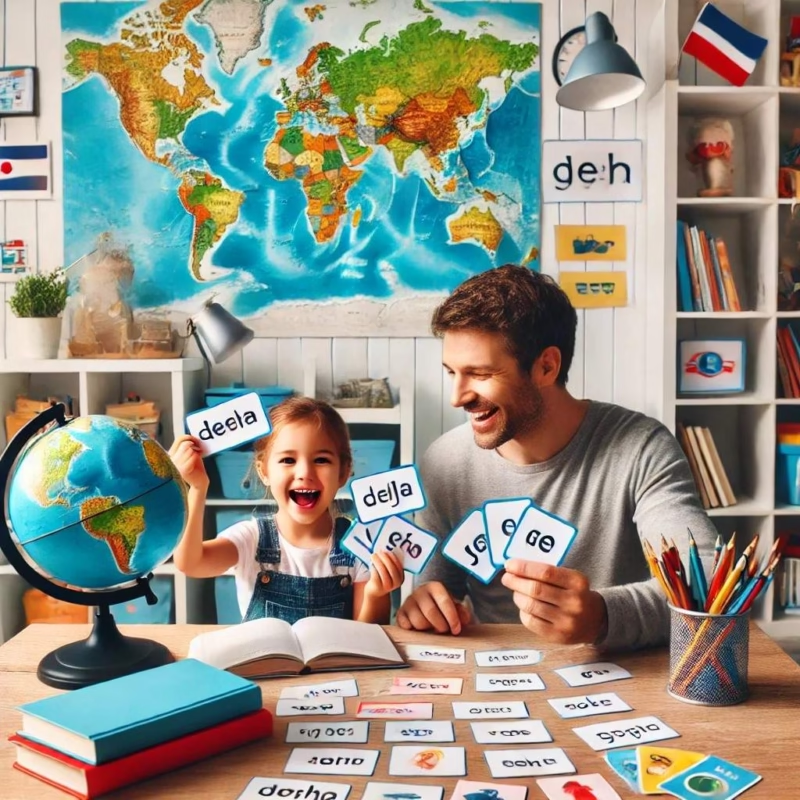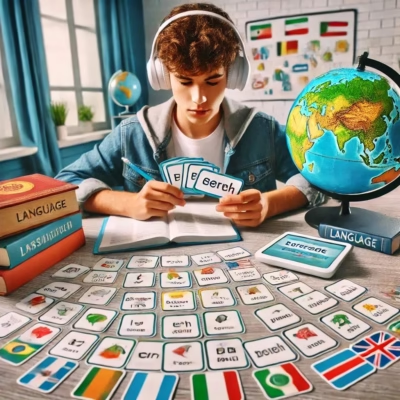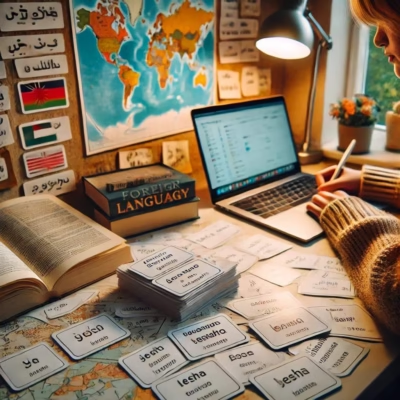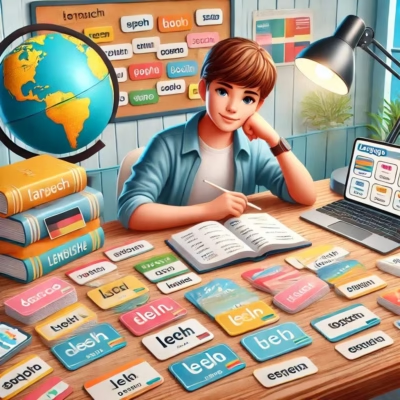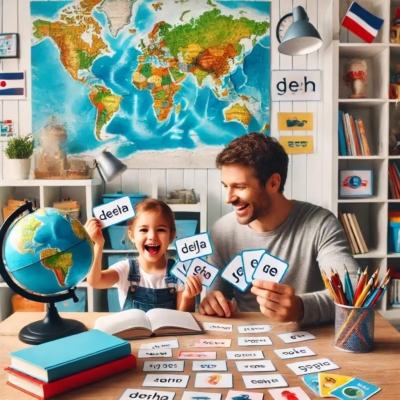Introduction: Why Flashcards?
The Importance of Vocabulary for ESL Kids
For children learning English as a second language (ESL), vocabulary is the foundation of communication. Before they can build sentences or understand grammar rules, they need words — words to name things, express feelings, and ask questions. Without a solid vocabulary base, language learning becomes frustrating and ineffective. That’s why helping kids absorb new words in an engaging and memorable way is essential.
How Flashcards Support Visual Learning, Repetition, and Memorization
Flashcards are more than just a stack of word-and-picture cards. They’re powerful tools that support visual learning, repetition, and memory retention. Children remember better when they can see a word, hear its pronunciation, and connect it to an image. Flashcards offer all of this in one simple format. Repeating the same cards over time reinforces learning and helps children move words from short-term memory to long-term understanding.
Why This Method Works Especially Well for Younger Learners
Young children are naturally visual and hands-on learners. They explore the world through play, colors, and tactile experiences. Flashcards tap into these learning styles by combining images, words, and interactive play. Whether you’re showing animal cards during story time or playing a memory-matching game, flashcards make learning feel like a fun game — not a lesson. And that makes a big difference.
What This Blog Post Will Offer You
In this post, you’ll discover:
Practical tips for using flashcards effectively at home or in the classroom
Creative game ideas that make vocabulary learning exciting
Insights into choosing or creating the right flashcards for ESL learners
Whether you’re a teacher, a homeschooling parent, or simply someone helping a child learn English, these strategies will help make vocabulary learning both effective and enjoyable.
Choosing the Right Flashcards
The Benefits of Ready-Made Sets
When it comes to teaching ESL vocabulary to kids, ready-made flashcard sets can save both time and effort — especially if you’re balancing a busy teaching schedule or parenting multiple children. Professionally designed flashcards often feature high-quality illustrations or photographs, ensuring the visuals are clear, attractive, and age-appropriate. Many sets are also laminated or printed on thick cardstock, making them more durable and long-lasting during repeated use.
If you’re looking for educational, visually appealing flashcards designed specifically for ESL learners, check out the DicipLearn Etsy Store. There you’ll find printable flashcard sets covering themes like fruits & vegetables, animals, jobs, and irregular verbs — all crafted to support vocabulary development through vibrant visuals and clean layout.
Features of an Ideal Flashcard
Not all flashcards are created equal. Whether you’re purchasing a set or creating your own, here are the key features to look for:
Clear, simple visuals: Choose images that are easy to recognize and not overloaded with details. Both photos and cartoon-style illustrations can work well — as long as the image clearly represents the word.
Readable text: Use a large, legible font with high contrast against the background. Keep the word or phrase short and age-appropriate.
Durable materials: For physical flashcards, opt for thick cardstock or laminated paper. This helps the cards withstand frequent handling, spills, and wear.
Kid-friendly size: Flashcards should be small enough for children to hold comfortably, but large enough for group display or classroom use. A size around 3×5 inches (7.5×12.5 cm) usually works well.
Types of Flashcards to Consider
There’s no one-size-fits-all approach. The best flashcard format may depend on the child’s level, the setting, and the learning goals. Here are a few common types to explore:
Picture-only cards: Great for vocabulary review and speaking practice. Children can describe or name what they see.
Word-only cards: Useful for spelling practice or matching games with images.
Picture + word cards: Ideal for beginners, especially visual learners. The word reinforces reading while the image supports understanding.
Question + answer cards: Promote interactive learning and critical thinking. For example, “What is this?” on the front, and the answer (“It’s a banana”) on the back — or even translations between English and the child’s native language.
Basic Flashcard Techniques for ESL Vocabulary
Flashcards are simple, but the way you use them can make all the difference. Here are some essential, classroom-tested techniques to get the most out of your ESL flashcards and keep young learners engaged and motivated.
1. Show and Tell
This is the most straightforward technique — and one of the most effective for beginners. Hold up a flashcard, say the word clearly, and have the child repeat after you.
👂 “This is a dog.”
🗣 “Dog.”
Encourage children to look closely at the picture, mimic your pronunciation, and repeat the word with confidence. Repetition builds familiarity and helps pronunciation stick.
2. Listen and Point
Lay out several flashcards in front of the child. Then say a word out loud and ask them to point to the correct card.
👨🏫 “Can you find the apple?”
🍎 (Child points to the apple card.)
This technique helps test listening skills and word recognition without requiring the child to speak — perfect for shy learners or those still building confidence.
3. Question and Answer
Turn vocabulary practice into conversation by asking simple questions while showing the flashcard.
❓ “What is this?”
🗣 “It’s a cat.”
🎨 “What colour is it?”
🗣 “It’s black.”
This approach not only teaches new words but also introduces sentence structure and basic grammar in context.
4. Native Language to English Matching
Help children make meaningful connections by using their native language alongside English. You can say the word in their first language and ask them to find the English card, or do the reverse.
👨🏫 “Gato— can you find the English card for that?”
🐱 (Child holds up “Cat” card.)
This reinforces understanding and helps bridge the gap between the two languages.
5. Make It Fun: Games and Activities
Flashcards don’t have to mean sitting quietly in a chair. Turn learning into a game! Here are a few quick ideas:
Memory Match: Lay cards face down and take turns flipping to find matches (e.g., picture + word).
Flashcard Hunt: Hide cards around the room and ask children to find specific ones.
Slap Game: Spread cards on a table. Say a word, and the first child to slap the correct card wins a point.
Hot Potato: Pass a flashcard around in a circle while music plays. When it stops, the holder says the word.
These activities add energy, excitement, and movement, helping kids stay focused while reinforcing vocabulary in a playful way.
Make Learning Fun: Flashcard Games and Activities
Young ESL learners absorb language faster when they’re actively engaged — and what better way to boost engagement than through games? Turning flashcard practice into play can turn a simple vocabulary session into a highlight of the day. Here are some fun, kid-approved flashcard games that also reinforce learning through repetition, movement, and imagination.
1. Memory Game (Matching Pairs)
Make two copies of each flashcard and lay them face down on a table or floor. Players take turns flipping over two cards, trying to find a match.
🧠 Great for: Improving memory and word recognition.
To adapt for different levels, you can pair pictures with words, or even English words with native language translations.
2. Flashcard Hide and Seek
Hide flashcards around the room and let the child go on a vocabulary treasure hunt! Each time they find a card, ask them to say the word aloud.
🔍 “You found ‘banana’ — can you say it?”
🍌 “Banana!”
🧠 Great for: Adding movement and reinforcing recognition through repetition.
3. What’s Missing?
Show the child 3–5 flashcards and let them study the cards. Then ask them to close their eyes while you remove one. When they open their eyes, they must guess which card is missing.
❓ “What’s missing?”
🤔 “The apple!”
🧠 Great for: Practicing observation, recall, and vocabulary review.
4. Flashcard Fishing Game
Attach a paperclip to each flashcard and use a toy fishing rod with a magnet to “catch” words! When the child catches a card, they must say the word before keeping it.
🎣 “You caught a tiger!”
🐯 “Tiger!”
🧠 Great for: Hand-eye coordination and spontaneous word recall.
5. Sorting and Grouping
Ask the child to sort flashcards into categories such as animals, food, clothing, colors, or actions. You can increase the difficulty by combining categories or introducing subcategories.
👕 “Can you put all the clothes together?”
🐶 “Now, find all the animals.”
🧠 Great for: Building vocabulary through themes and improving critical thinking.
6. Tell a Story
Choose 3–5 random flashcards and help your child create a short story using those words. It doesn’t have to be perfect — just fun and imaginative.
📖 “Once upon a time, a dog and a banana went to the zoo…”
🧠 Great for: Practicing sentence structure, creativity, and contextual vocabulary use.
7. Charades (Act It Out!)
Pick an action flashcard or a noun and act it out without speaking. Let the child guess what it is. Then switch roles!
🤫 [Pretends to eat]
🤔 “Are you eating pizza?”
🧠 Great for: Practicing verbs and common objects, plus it’s a guaranteed laugh!
Learning through play not only keeps kids engaged — it also helps them remember vocabulary in a more meaningful way. With these games, flashcards become tools for connection, creativity, and confidence.
Tips to Maximize the Effectiveness of Flashcard Learning
Even the best flashcards need the right strategies to shine. Here are some practical, teacher-approved tips to help you get the most out of your ESL flashcard sessions — especially when working with kids.
1. Keep It Short and Sweet
Children have short attention spans, so aim for frequent mini-sessions rather than long ones. A quick 5–10 minute review session can be far more effective (and fun!) than a 30-minute drill.
💡 Tip: Try multiple short sessions throughout the day — during snack time, before bed, or while waiting in line.
2. Stay Positive and Encouraging
Focus on what the child does well. Instead of pointing out mistakes, celebrate correct answers and praise their effort.
😊 “You tried so hard — great job!”
🎉 “Yes, that’s a lion! Well done!”
This keeps motivation high and builds confidence.
3. Emphasize Clear Pronunciation
Model clear and correct pronunciation. If you’re unsure, use online dictionaries or pronunciation tools (like Cambridge or Forvo) to guide you.
🗣️ Children will naturally imitate the sounds they hear — make sure they hear the right ones!
4. Use Words in Context
Don’t just say isolated words. Use them in simple, meaningful sentences. For example:
🍎 “Look! A red apple!”
🐶 “The dog is running!”
Context helps children understand the word’s meaning and usage more deeply.
5. Repeat, Repeat, Repeat
Repetition is key to language learning. Review previously learned words regularly using different activities and games to keep it fresh and fun.
🔁 “Did we play memory with food cards today? Let’s use them again in a story!”
6. Follow the Child’s Interests
Engagement skyrockets when you use content that kids already love. Does your child adore animals? Start with animal flashcards. Love cars or dinosaurs? Find themed sets that excite them!
❤️ Personal interest = personal investment in learning.
7. Use Visual Variety
Mix things up with different visual styles — drawings, cartoons, and real-life photos. This keeps things visually stimulating and helps reinforce recognition across contexts.
🖼️ “That’s an apple in a cartoon. Now let’s find a photo of a real apple!”
8. Go Beyond Nouns
Many people focus only on naming objects, but verbs and adjectives are just as important. Teach action words like “run” or “sleep,” and adjectives like “happy” or “big” with simple visuals and movements.
🤸 “Can you show me ‘jump’? Let’s jump together!”
😄 “Show me a happy face!”
With these tips, your flashcard sessions will become more than just learning—they’ll be moments of connection, discovery, and joy. And remember: consistency and encouragement are the magic ingredients in every child’s language journey.
Common Mistakes to Avoid When Using Flashcards with ESL Kids
Flashcards are an incredible tool — but like any tool, they’re most effective when used correctly. Here are some common pitfalls to watch out for when teaching English vocabulary to children, and how to avoid them:
1. Using Too Many Cards at Once
One of the most frequent mistakes is overloading the child with too much information. Trying to introduce 20 new words in one session can be overwhelming and counterproductive.
✅ Focus on 3–5 new cards at a time. Mastery over quantity is key.
2. Making Sessions Too Long or Forcing Participation
Learning should feel like play — not a chore. Long, forced sessions can lead to frustration and burnout.
🚫 Don’t push the child if they’re tired or uninterested.
✅ Keep sessions short, flexible, and responsive to their mood.
3. Focusing Only on Memorization
Rote memorization has its place, but true learning happens when children understand and use words in context.
🚫 Avoid just drilling word-for-word translations.
✅ Encourage using the word in a sentence, acting it out, or linking it to a real-world object.
4. Forgetting the Fun
Flashcards don’t have to be boring! Skipping the games, songs, and playful activities can make learning feel dull and mechanical.
🎲 Turn practice into play — use games like “What’s Missing?” or “Charades” to spark excitement and energy.
5. Not Reviewing Enough
Once a word is “learned,” it still needs regular review to stick in long-term memory. Without repetition, even well-learned words can fade quickly.
🔁 Recycle old cards into new games and stories.
🧠 Spaced repetition = smarter learning.
Avoiding these common mistakes can transform flashcard learning from a passive activity into an engaging, effective experience — one that kids actually look forward to!
Conclusion & Encouragement
Flashcards, when used correctly, can be one of the most powerful tools in helping ESL kids build and retain vocabulary. Their visual, interactive nature makes them perfect for young learners who thrive on repetition, games, and hands-on activities.
But like any educational method, success with flashcards doesn’t come overnight.
🌱 It takes patience, consistency, and a playful spirit.
Don’t worry if progress feels slow at times — language learning is a journey, and every word learned is a step forward.
We encourage parents, teachers, and caregivers to try the techniques and games shared in this post. Make flashcards a regular part of your child’s learning routine, but keep it light, fun, and personalized to their interests.
✨ Looking for ready-to-use, beautifully illustrated ESL flashcards?
Visit our DicipLearn Etsy Shop for educational sets that are both engaging and effective — designed with real learners in mind!
With the right tools and a joyful approach, you’ll be amazed at how quickly children begin to understand, use, and even love the English words they’re learning.
You’ve got this — and so do they! 💪🎉

